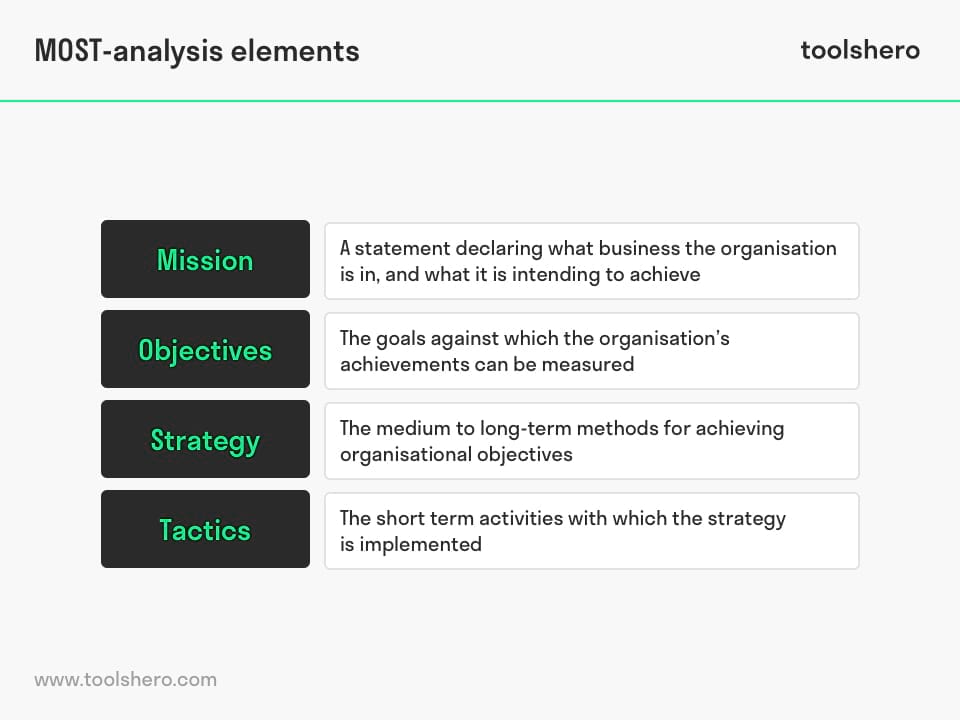MOST Analysis technique

MOST Analysis: this article provides a practical explanation of the MOST Analysis. In addition to what this analysis technique is, this article highlights the role of the mission with this tool and the key points of this technique. After reading you will understand the basics of this strategy tool. Enjoy reading!
What is the MOST Analysis?
The MOST Analysis is an analytical technique that is used for strategic planning and strategy development. The technique is used to evaluate what an organisation wants to achieve (through a mission statement and objectives), and how it wants to achieve this (through strategy and tactics).
The simple tool starts with the organisation’s mission statement at a high level, then goes into more detail about individual tactics. Within the planning process, it’s important that there should be a logical connection between the mission and what is done daily to achieve it.
The name MOST Analysis is an acronym composed of the following four elements:

Figure 1 – the elements of the MOST Analysis
Mission
The mission defines in which industry the organisation operates and what it wants to achieve there in the long term.
Objectives
Objectives are goals by which the organisation’s success can be measured.
Strategies
Strategies are medium-term to long-term approaches to achieving the organisation’s objectives.
Tactics
Tactics are used to define the short-term activities and projects with which the strategy is implemented
Organisational focus
A company is often founded from a specific vision, using a business plan as its basis. As soon as the company is up and running, it’s easy to lose sight of the plan or vision. There are countless activities on a daily basis that cause the course to slowly deviate from what the management initially envisioned. After all, staying on course requires a close connection between long-term goals and short-term activities.
This is where the MOST Analysis can be valuable. The idea behind the technique is to organise activities for mutual support, so that everyone moves into the same direction. Without this coherence, the future could look less pretty than predicted.
MOST Analysis as a tool for companies
The MOST Analysis helps companies break through communication barriers between various levels within teams by asking during every phase: ‘How does this help us to achieve our next-level goals?’ Each tactic used should be justified in terms of achieving the objectives, in support of the strategies. All of this should be aligned with the organisation’s mission statement.
The analysis can be applied to most areas of an organisation, from the most obvious application in sales to marketing and activity optimisation of internal processes and human resources.
1. Mission in the MOST Analysis
Mission is an expression of the meaning and goal of the organisation’s existence. It’s a statement of why the organisation exists, what it wants to do, and what it can do. A basic consequence of the mission for each organisation is to offer a service to customers, or to sell products.
The mission statement helps to realise why the organisation exists or why it was founded. It’s important for employees to be one with this mission. The mission statement is also important to others, such as managers, customers, or other stakeholders.
A good mission is not formulated generally but specifically, and should be able to be understood by all employees and other interested parties. Ideally, everyone should be able to identify with this statement. Peter Drucker, known from the ‘Management by Objectives’ theory, defines the mission statement as follows,
“When we want to know what the business really is, we must start from the purpose of its existence. This purpose shall be outside of the business itself. Truly it must lie in society since the organization is a body of the society. There is only one acceptable definition of the purpose of a business: it is to create a customer..”
In summary, the mission statement is the main goal in the business plan from which the company resulted. It’s the main reason to do business from the highest level of the organisation and expresses what you want to achieve. The more specific the mission, the more successfully the rest of the aspects in the MOST analysis can be filled in.
Example mission for companies
Suppose you have a coffee-roasting business in the city centre. In this case, you can assume that the mission is to be the best possible coffee roaster and to impress each customer with stories about the coffee’s origins. This sounds good, but in terms of a mission it doesn’t say much. After all, this goal doesn’t really give you a direction in which to continue.
Instead of that, becoming the best coffee roaster in this city and its surroundings is much more tangible and specific. When the majority of companies and consumers come to your company for your roasted coffee, you know that the objective has been achieved. You then take the rest of the MOST analysis framework in order to make this possible.
2. Objectives in the MOST Analysis
Objective is a term used to describe the desired state of being for an organisation, individual, team, or unit. Objectives are usually the basis of control for the management and are applied in planning (strategic management), but also in operational management. Systematically formulated goals within organisations are balanced and based, among other things, on data from the balanced scorecard.
A well-formulated objective meets the conditions and principles of SMART (objectives are specific, measurable, attainable, realistic, and timely). On the way to objectives, they are monitored, measured, and verified using indicators and statistics.
Example objective for companies
Following through from the previous example, your coffee roasting company should emphasise those objectives that indicate how you can become the best coffee roaster of the city and its surroundings.
An objective could then be, for example, to increase revenue with 10% a month, to attract X number of customers before the end of the year, or to receive a certain portion of the orders online. Objectives should be measurable so that the various methods and techniques used to achieve them can be verified.
3. Strategies in the MOST Analysis
Strategy refers to a long-term plan designed to achieve a specific goal. The strategy is one of the results of strategic management. The word strategy is derived from Greek, and was mainly used in the army. Strategy means as much as ‘the art of commanding an army’.
In practice, strategies really are requests from interested parties, such as shareholders, about the organisation’s management. They help unite and steer employees’ behaviour and actions. The strategy is usually written down in a formalised document that contains a description of the first phases of the strategic cycle.
Furthermore, it contains a description of an organisation’s mission, vision, and strategic objectives, including a diagram or plan for implementation.
There can be only one main strategy, also known as business strategy or global strategy. This usually determines the organisation’s direction.
Example strategy for companies
In order to attract customers away from the competition, for example, the coffee roaster could offer a promotion, making each price lower than the competition’s. New investments in marketing techniques such as online advertisements or local radio commercials could also be a strategy for becoming the city’s largest coffee roaster.
Which strategy works depends on the market and the target audience. However, the idea works the same way for each company.
Make a list of strategies that can be used to achieve your objectives. Adjust the strategy if, over time, it proves not effective enough. Strategies should be specific, useful, and feasible.
4. Tactics in the MOST analysis
Tactics are methods and techniques used within the organisation to achieve objectives, carry out strategies and realise SMART goals. They are usually simple processes that concern information, and team members or employees should be able to carry them out, even if they were not directly involved in doing the MOST analysis. That’s why it’s important that tactics, just like goals, should be SMART and effective.
Example tactics for companies
For the coffee roaster, a tactic related to marketing techniques could mean, for example, writing the script for these commercials, hiring a marketing specialist, etc. The goal of tactics is to dictate daily activities such that the organisation is led to the proper direction of the general mission.
MOST Analysis core points
The MOST Analysis is summarised in the following core points:
- A simple tool for analysing and planning the details of a company’s actual activity
- It helps frame thinking about the mission at a high level
- The acronym MOST stands for Mission, Objectives, Strategies, and Tactics
- The mission answers the question: what does the organisation do?
- The strategy contains high-level decisions and requests that shape daily activities
- Tactics are used to carry out strategic decisions in practice
Now it’s your turn
What do you think? Do you recognise the explanation about the MOST Analysis? What other tools for strategic management do you know? Are you involved in carrying out a MOST analysis in your work environment? Do you know your company’s mission and objectives? Do you have any tips or additional comments?
Share your experience and knowledge in the comments box below.
More information
- Casadesus-Masanell, R., & Ricart, J. E. (2010). From strategy to business models and onto tactics. Long range planning, 43(2-3), 195-215.
- Cochran, D. S., David, F. R., & Gibson, C. K. (2008). A framework for developing an effective mission statement. Journal of Business strategies, 25(2), 27.
- David, F. R. (1989). How companies define their mission. Long range planning, 22(1), 90-97.
- Khalifa, A. S. (2012). Mission, purpose, and ambition: redefining the mission statement. Journal of Strategy and Management.
How to cite this article:
Janse, B. (2020). MOST Analysis technique. Retrieved [insert date] from Toolshero: https://www.toolshero.com/strategy/most-analysis/
Original publication date: 02/25/2020 | Last update: 09/07/2023
Add a link to this page on your website:
<a href=”https://www.toolshero.com/strategy/most-analysis/”>Toolshero: MOST Analysis technique</a>












